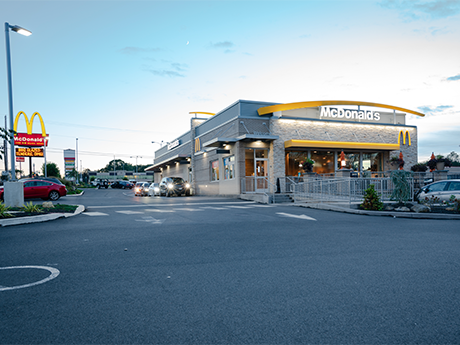With high operating costs eroding profitability at many urban stores, major retailers are concentrating development and store renovations in suburban locations with layouts geared to the latest consumer preferences. As more retailers follow suit, early adopters provide object lessons in best practices to better serve an evolving customer base and reveal pitfalls to avoid along the way.

Bohler
“Retailers are more sensitive to the pressures of high costs and loss prevention in urban markets, and as a result, they are backing off in those areas,” says Cornelius Brown, a principal and regional manager in the Philadelphia office of Bohler. “Retailers looking to grow, in our experience, are shifting to the suburbs and using retail program methods to cut costs.”
Bohler is a land development design and consulting firm that helps developers move their projects forward quickly. Recently, those clients have been keen to avoid risk in both site selection and design features, Brown says.
Streamlining Retail Development
Retail programs allow developers to use pre-existing retail layout prototypes to determine optimal site arrangements. This approach uses checklists to assign one of several pre-made layouts to a development based on factors such as road location, grading and elevation, parking needs, drive-through layout, loading requirements and more. The program allows a streamlined approach to repeated processes within retail development.

Bohler
“Our larger clients, that have been doing this for decades, have fairly very well-developed design standards that we follow,” says Eric Dubrule, an associate at Bohler’s office in Southborough, Massachusetts. “They typically will have one or two proto-building layouts that they like to use. They can recycle those and save on their development costs.”
“With the more established retailers, not only do they have standards, but they also have standards that change pretty consistently,” agrees Brown. “Any change with these experienced entities, you can almost always trace it back to an issue. Perhaps there’s a problem somewhere — a trip and fall issue or an issue with efficiency in the kitchen area. The established retailers address it, and they issue updated standards accordingly.”
Due Diligence to Help Build Realistic Timelines and Expectations
“Not only are developers highly selective and choosing only Main-and-Main, high-traffic areas, but they are also exercising due diligence to make sure they understand all of a project’s potential issues ahead of time, as opposed to stumbling upon unexpected costs during development,” Brown says.
Opportunities to mitigate risk extend beyond site selection to include a retailer’s choices in site design, structural features and the layout of parking, buildings, utilities and open space. Large brands tend to have finely tuned development programs that inform those decisions, following best practices to streamline development, minimize cost and maximize customer traffic, often through pre-made retail program plans. Smaller chains and independent operators may have more design flexibility, but typically adopt mainstream strategies that appeal to their targeted customers.
Drive-Through, Curbside Pickup Expanding
Customers have embraced the speed and convenience of drive-through windows and ordering food or other purchases for delivery or curbside pickup. That has made drive-through lanes and dedicated parking for pickup and delivery drivers a must-have design consideration for many retailers.
And it’s not just quick-service restaurants queuing up to build these features: Grocery stores and even some big-box retailers are adding drive-through lanes and dedicated parking for curbside and delivery services.
“Post-COVID, there has been an explosion in delivery services and drive-through use,” Brown says. “A lot of restaurants are just not seeing the same traffic in their dining areas as they are in drive-throughs, and as a result, they are reconfiguring for greater drive-through efficiency. That may mean removing an old cash collection window and adding another order station, making the kitchen more efficient or setting aside space for delivery drivers.”
For existing locations, retailers must balance the potential advantages of making improvements for greater efficiency against the hard and soft costs of reconstruction. Bohler helps customers identify and reduce project costs through careful design, securing necessary approvals and ensuring conformity with zoning and other parameters for an efficient construction phase.
“Change to an existing location has a hard cost, in terms of construction, as well as the costs of lost opportunity when customers can’t fully access the site while the work is performed,” Brown says. “Once clients understand and prepare for all of these factors, it is usually worth the investment in a more efficient operation and improved customer experience. They look to the long-term play.”
Rethinking Parking Allocations
When a grocery store or big-box retailer chooses to add a drive-through lane, curbside pickup or both, an obvious option is often to repurpose parking spaces next to its building. Some sites may require partial demolition of a building to create space for the new activity.
Alternatively, an owner may seek to replace existing parking spaces with charging stations for electrical vehicles (EVs), which may also require room for an electrical substation and other equipment. Some grocery stores, large-format retailers and shopping centers now offer EV charging as a customer service that can generate repeat traffic and encourage shoppers to prolong their visit while their vehicles charge.
Dubrule says any proposed parking change is a red flag signaling the need for a deep dive into the property’s zoning and land-use rules. Even a reconfiguration that leaves the total number of parking spaces unchanged can create conflicts with utility placement, traffic patterns or other parameters set by zoning, building code or site plans.
“There’s a lot of research and engineering that goes into understanding where a new feature goes on the site, planning how it will function and how traffic will flow with the rest of the operations there,” Dubrule says. “A lot goes into adding a feature, whether it is for a grocery store or a large-box retailer.”
In some instances, zoning ordinances don’t address an intended use, Brown says. The original authors of building codes were unlikely to contemplate a need for drive-through lanes at a grocery store, for example, or to envision EV charging stations.
It may be necessary for the developer’s team to educate municipal staff about the proposed use or to help the community establish local rules for the activity. That underscores the need for thorough research and an understanding of how progressive communities are regulating emerging land uses.
“Some municipalities are sophisticated and have kept up with development trends,” Brown says, “but where codes are outdated, zoning and site plan approval may take a little longer.”
— By Matt Hudgins. Bohler is a content partner of REBusinessOnline. For more articles from and news about Bohler, click here.


